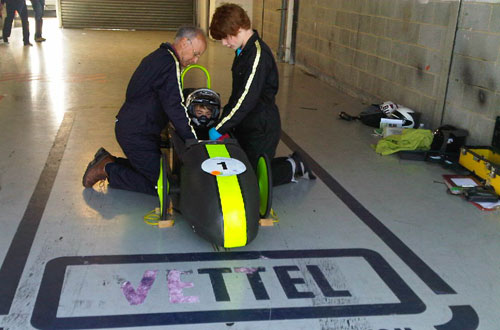Columns -
The Next Newey

BY MAURICE HAMILTON
I went to Silverstone recently and saw the future of motor sport. But I didn't hear it. </p> <p>There was a race - a very serious race - but you only knew it was over when one group of the many at the pit wall starting jumping up and down. Their whoops and hollers drowned the sound of the winning car as it rolled quietly and slowly across the line: deathly quiet compared to the usual raucous nature of competition machinery at this famous place; incredibly slow by any Silverstone standard. But the technical inventiveness associated with the victorious machine and those around it matched, in its own small way, the ingenuity on display when the F1 cars tore up the same piece of track during the British Grand Prix. </p> <p>Welcome to Greenpower. The difference between this and F1 is that Greenpower is looking to encourage the next Adrian Newey rather than a future Sebastian Vettel. It is not about the team of racers taking their turn behind each steering wheel; Greenpower is focussed on inspiring and motivating the creative brains that produced the hardware the youngsters are sitting in. And judging by an entry of more than 40 cars, motor sport is not short on nascent technical talent.</p> <p>Greenpower is about the powering of a machine by a pair of batteries driving an electric motor. That is the basic formula, one which, typically for motor sport, has been revised to curtail costs and speed since its introduction in 1999. It is also no surprise to learn that the devil lies in the detail. Finding the competitive edge comes from keeping aerodynamic drag and rolling resistance to the minimum. And that goes beyond the obvious need to have skinny wheels and enveloping bodywork.</p> <p>Greenpower's technical freedom has seen telemetry, data loggers, fly-by-wire throttles, not to mention intelligent gearboxes that trade aerodynamic drag with acceleration and hill climbing ability. Silverstone may seem completely flat when driving an F1 car, but the rise from Copse to Maggotts is an endless incline when urging your silent machine to go faster while thinking about eking out the available power.</p> <p>Recharging is not allowed and each car can use three pairs of batteries during a race, thus making pit stops more than simply a driver-change routine. Races last for more than 120 miles, at an average of 30mph. The running cost necessary to achieve this? As little as 30 pence (50 cents).</p> <p>But the experience is priceless. Aimed primarily at schools and colleges, Greenpower has long since ventured beyond that. The top 15 schools can challenge teams from industry, the Silverstone event boasting entries from Bentley, Jaguar/ Land Rover, Peugeot, Citroen and Siemens. Among the college representatives came teams from Cambridge, Dundee and as far away as the Silesian University in Poland. </p> <p>The quality of workmanship has to be seen to be believed. Jaguar's apprentices (the maximum age is 25) produced an immaculate injection moulded body. The small Electroad team from Sussex (the eventual winner) devised a plywood chassis that involved vacuum bagging and curing like carbon composite; lightweight, clever - but also inexpensive and green. This is fun motor racing but with a serious purpose.</p> <div class="wsw-Photo" style="width: 500px"><a href="http://www.grandprix.com/jpeg/misc/mh1-lg.jpg"><img height="330" width="500" src="http://www.grandprix.com/jpeg/misc/mh1-rg.jpg" alt="" /></a></div> <p>Apart from the design and build process, participants must also deal with sponsorship and budget restraints while developing leadership and team skills as well as an underlying sense of responsibility and safety awareness. - necessary when the cars can reach 50 mph with, quite literally, a following wind.</p> <p>This is one racing formula where downforce is not a major consideration (the heavy batteries see to that). Without wings and bargeboards, the cars have the aesthetic elegance of a high-performance glider, albeit one that sweeps silently by on the ground.</p> <p>It so happened that the winning car, The Simple Trug, was allocated the space used by Sebastian Vettel in what were then the garages for the 2010 British Grand Prix. The Simple Trug's rubber footprint may have been miniscule compared to the former occupant from Red Bull, but this little car had been part of a silent armada taking a giant step for the benefit of tomorrow's motor sport. Fun to watch - but hard to hear.</p> <p>(Further information: <a href="http://www.greenpower.co.uk">www.greenpower.co.uk</a>) </p> <p><script src="http://connect.facebook.net/en_US/all.js#xfbml=1"></script><fb:like href="http://www.grandprix.com/columns/maurice-hamilton/the-next-newey.html" layout="box_count"></fb:like>